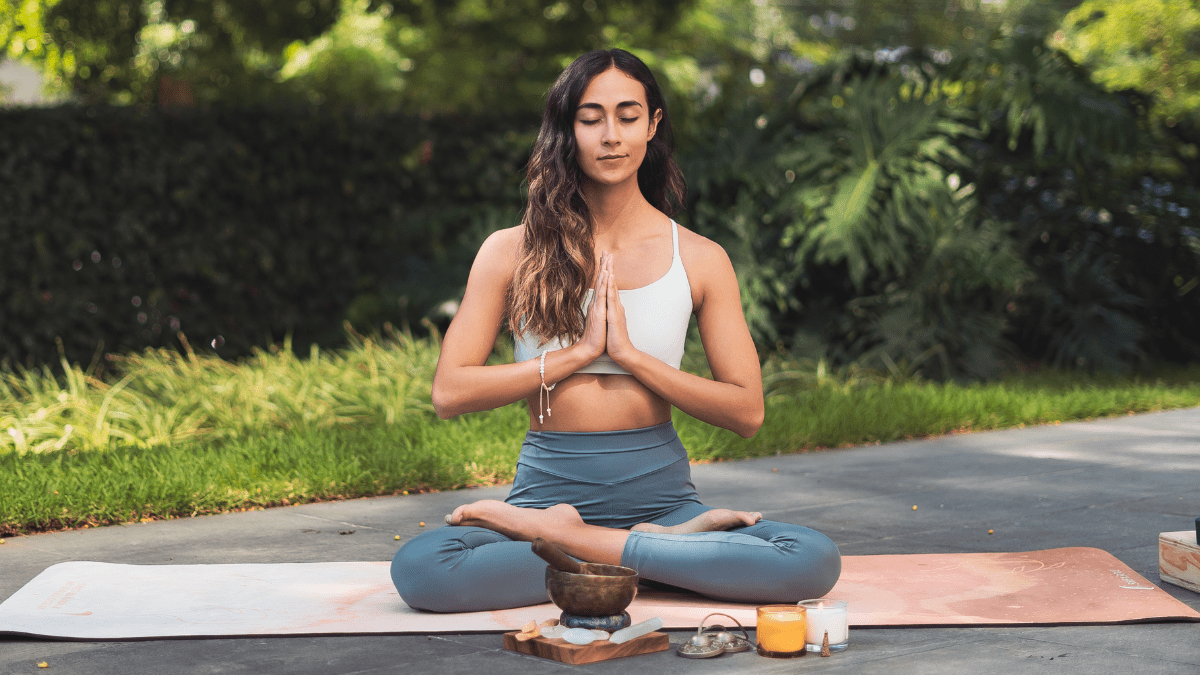10 Minute Meditation for Stress: The Fast Calm You Need Now
This 10 minute meditation for stress delivers fast calm, powerful emotional relief, and inner clarity. Start today—peace, focus, and freedom are just minutes away.

In This Article
- Why Start with a 10 Minute Meditation for Stress?
- 1. Why Try A 10 Minute Meditation For Stress Relief?
- 2. How To Prepare For A 10 Minute Meditation For Stress
- 3. Guided Vs. Silent: What’s Best For A 10 Minute Meditation For Stress?
- 4. What Happens In Your Body During A 10 Minute Meditation For Stress?
- 5. How To Make A 10 Minute Meditation For Stress A Daily Habit
- Final Thoughts On 10 Minute Meditation For Stress
- 10 Minute Meditation For Stress — FAQ
Why Start with a 10 Minute Meditation for Stress?
Can You Really Find Peace in Just 10 Minutes?
Stress builds quickly. It drains your energy, clouds your thinking, and tightens your entire body. However, what if you could reset everything in just 10 minutes? That’s exactly where a 10 minute meditation for stress can make a huge difference.
While it may seem too brief, even a short session can ease anxiety, clear mental fog, and ground you emotionally. In fact, science continues to prove that small moments of mindfulness often create the biggest shifts.
Even better, you don’t need special tools or years of practice. Instead, you just need a quiet space, a few deep breaths, and a willingness to slow down. As you’ll soon discover, peace is always within reach—even on your busiest days.
Let’s begin.
1. Why Try A 10 Minute Meditation For Stress Relief?
What Makes Just 10 Minutes So Powerful For The Mind?
To get the most from your session, the space you choose matters. A calm space helps signal your body that it’s time to slow down. Fortunately, you don’t need a meditation studio. Even a quiet corner can become a peaceful retreat.
To improve your meditation space quickly:
- Choose a spot with minimal distractions
- Dim the lights or use natural light
- Use a cushion, chair, or folded blanket for comfort
Next, consider adding grounding tools. A soft scent like lavender or gentle background sounds can deepen your focus. The goal isn’t perfection. It’s comfort.
Is Stress Stealing Your Focus And Energy Daily?
First, stress clouds your thinking. Then it affects your sleep, digestion, and mood. Over time, it becomes chronic—and dangerous.
Yet, a 10 minute meditation for stress helps stop that cycle. Instead of pushing through overwhelm, you press pause. That moment of stillness gives your mind a reset.
Here’s how stress shows up:
- Racing thoughts or scattered focus
- Irritability or constant worry
- Tension in the neck, jaw, or chest
If you experience any of these, even one short session can shift your state.
Can You Really Shift Your State That Quickly?
Yes—and here’s why. Meditation slows your breathing. Slower breath tells your body that you’re safe. As a result, stress hormones like cortisol begin to drop.
To improve how quickly you relax, try:
- Counting each inhale and exhale
- Visualizing a peaceful place
- Listening to calming music or nature sounds
Even if your thoughts wander, the act of returning is where the transformation happens.
Mini Meditation Checklist:
- Find stillness
- Focus on your breath
- Gently release distractions
- Repeat for 10 minutes
If you’re ready to reset your system in just minutes, this 10 minute meditation for stress method will show you how to shift your energy fast and stay grounded.
2. How To Prepare For A 10 Minute Meditation For Stress
What’s The Ideal Environment For Instant Calm?
To get the most from your session, the space you choose matters. A calm space helps signal your body that it’s time to slow down. Fortunately, you don’t need a meditation studio. Even a quiet corner can become a peaceful retreat.
To improve your meditation space quickly:
- Choose a spot with minimal distractions
- Dim the lights or use natural light
- Use a cushion, chair, or folded blanket for comfort
Next, consider adding grounding tools. A soft scent like lavender or gentle background sounds can deepen your focus. The goal isn’t perfection. It’s comfort.
Do You Need To Sit Still Or Be On A Mat?
Absolutely not. Meditation is flexible. You can sit in a chair, lie down, or rest on a sofa. What matters most is posture. A supported spine helps you stay alert yet relaxed.
The best positions for 10 minute meditation for stress include:
- Seated upright on a chair with feet grounded
- Cross-legged on a cushion
- Reclining flat with a pillow under your knees
Above all, choose a posture that supports your breath. That alone will help your body relax faster.
What Should You Let Go Of Before You Begin?
Before starting, it helps to release the mental noise. Stress builds from layers of thought. The best way to shift your state is to let go—gently and without force.
Here’s how to prepare your mindset:
- Set a simple intention (like “I choose peace”)
- Acknowledge your current mood without judgment
- Decide to return to the breath when distracted
Even if your day has been chaotic, this step anchors you in presence. In fact, it’s where the meditation begins.
If you’re still unsure how to ease into stillness, this Yoga Nidra for Deep Sleep is a wonderful practice to explore when you need deeper rest.
3. Guided Vs. Silent: What’s Best For A 10 Minute Meditation For Stress?
Are Guided Meditations Better For Beginners?
For many, silence can feel intimidating at first. However, guided meditations offer a helpful structure. With a calm voice leading you, it’s much easier to stay focused. Even better, you don’t have to guess what to do next.
Moreover, guided meditations can remove the pressure of “doing it right.” They gently remind you to return to your breath when your mind wanders. As a result, your stress begins to ease without effort.
To improve your first experience:
- Choose a trusted app or voice you enjoy
- Start with shorter 5–10 minute sessions
- Focus on consistency rather than perfection
Ultimately, guided meditations build confidence. Then, once you’re comfortable, you can explore other styles.

Can Silence Feel Overwhelming At First?
Yes, and that’s completely okay. At first, silence may feel loud. Without a voice to follow, your thoughts might race. Still, that’s part of the process—not a sign of failure.
Thankfully, there are ways to ease into silence. For instance, soft music or nature sounds can offer comfort. Even subtle background tones can calm your nervous system and support focus.
Here’s how to make silent sessions more accessible:
- Use a gentle timer instead of loud alarms
- Keep your eyes softly open if needed
- Try breathing with sound, like ocean breath or humming
Over time, silence may become your favorite form of meditation.
How Do You Know What Style Works For You?
Truthfully, it depends. While one person feels at ease with silence, another may crave guidance. That’s why it’s important to experiment. Only by trying both will you discover what works best for you.
To improve your practice quickly:
- Alternate between guided and silent sessions
- Journal how you feel afterward
- Track your focus, emotions, and stress levels
Eventually, your preferences will become clear. Some days may call for quiet. Others might require a guiding voice. Either way, what matters is how you feel afterward.
To find what brings you the most peace, try both silent and guided styles during your 10 minute meditation for stress until one feels natural.
4. What Happens In Your Body During A 10 Minute Meditation For Stress?
How Does Stress Physically Leave The Body?
When stress builds, your body enters survival mode. Your breath shortens. Muscles tighten. Cortisol, the stress hormone, floods your system. However, with just 10 minutes of mindfulness, your entire state can shift.
To start, meditation activates the parasympathetic nervous system. This helps the body switch from fight-or-flight to rest-and-digest. As your breath slows, your heart rate begins to regulate. Meanwhile, cortisol levels begin to drop.
To improve physical release during your practice:
- Breathe deeply and slowly
- Exhale longer than you inhale
- Soften the muscles of your face and shoulders
Over time, your body learns this pathway back to calm—faster and more naturally.
Can Meditation Change Your Brain In Minutes?
Yes, and research supports it. Even brief meditation creates changes in the brain’s structure and function. Specifically, it calms the amygdala—the center of fear and anxiety. At the same time, it strengthens the prefrontal cortex, which governs focus and emotional control.
In fact, studies show just one session can boost clarity and emotional resilience. Though long-term practice deepens the benefits, short daily meditations still rewire your responses.
To boost brain benefits during a 10 minute meditation for stress:
- Focus on present-moment sensations
- Use breath as an anchor for attention
- Let go of judgment and gently return when distracted
Gradually, meditation becomes less about effort and more about release.
What Do People Feel After 10 Minutes Of Mindfulness?
Most people feel lighter. Others report clarity, warmth, or a quiet sense of ease. Even if the practice feels subtle, something inside shifts. Emotional tension often melts away—sometimes without words.
Even better, these results don’t require perfection. You can fidget, wander, or worry—and still walk away feeling more balanced than before.
Common emotional shifts after 10 minutes:
- A sense of grounded calm
- Less racing thoughts
- Improved patience and presence
5. How To Make A 10 Minute Meditation For Stress A Daily Habit
What’s The Easiest Time To Meditate Each Day?
To begin, timing matters more than most people realize. Although stress can hit at any hour, your body responds best to regular rhythms. That’s why choosing a consistent time is key.
Often, mornings offer a quiet space before the world wakes up. However, midday breaks or evening routines also work beautifully. It all depends on your lifestyle and mental energy.
To improve your meditation schedule:
- Meditate right after brushing your teeth
- Set a recurring phone reminder
- Keep a meditation journal by your bedside
That way, your practice becomes automatic—like a breath of calm you look forward to each day.

How Can You Stay Consistent Without Forcing It?
Staying consistent doesn’t require willpower. Instead, it requires kindness. First, remove the pressure to be perfect. Then, treat meditation like a gift you give yourself—not another task to complete.
Next, start small. Ten minutes is enough. Even five is better than none. Over time, the habit will build itself.
To make your 10 minute meditation for stress easier to stick with:
- Pair it with something you already do daily
- Create a visual cue like a candle or cushion
- Celebrate each session, no matter how short
That way, meditation feels less like a duty and more like a doorway to peace.
What If You Miss A Day Or Can’t Focus?
Missing a day doesn’t undo your progress. In fact, how you respond matters more than the missed session. If you fall off track, return without guilt. The mind learns through repetition—not perfection.
Also, on days when your focus scatters, meditation still helps. Even distracted practice rewires your stress response over time.
To improve your mindset after setbacks:
- Remind yourself that every breath is progress
- Try shorter, softer sessions when overwhelmed
- Keep going—even if it feels messy
Final Thoughts On 10 Minute Meditation For Stress
By now, you know that peace doesn’t require hours of silence. In fact, it only takes intention—and just 10 minutes. Even in the busiest moments, calm is within reach.
Throughout this post, you’ve explored why short meditations work, how to prepare, and which style fits your needs. You’ve learned what happens inside your body and how to create a daily rhythm that supports long-term emotional balance.
Most importantly, you’ve discovered that healing can begin in as little as one breath.
To begin your own 10 minute meditation for stress today:
- Choose a time that feels natural—morning, midday, or night
- Pick your space—quiet, comfortable, and undisturbed
- Decide your style—guided, silent, or soft background music
- Commit gently—even if it’s not perfect, just start
If you want to explore other powerful ways to calm your mind, consider this guide to Brain Flossing Meditation. It’s another powerful path to clarity and inner stillness.
Remember, stress doesn’t have to control your day. You have the power to pause. You have the ability to reset.
Because every time you sit in silence, you rewrite your relationship with stress. And sometimes, the most life-changing shifts begin with just 10 minutes.
You’re only one breath away from balance.
10 Minute Meditation For Stress — FAQ
What Is The Best 10 Minute Meditation For Stress Relief At Home?
The best 10 minute meditation for stress relief at home is one that’s easy, quiet, and tailored to your comfort. Start by choosing a distraction-free space—your bedroom, a corner of your living room, or even outdoors. Then, sit or lie down in a relaxed position. Set a timer for 10 minutes. Focus on slow breathing or follow a simple guided meditation. To improve your experience, use soft music or nature sounds. Even better, practice at the same time each day to build consistency.
Can A 10 Minute Daily Meditation Really Reduce Stress And Anxiety?
Yes, a 10 minute daily meditation can significantly reduce stress and anxiety. Scientific research confirms that even brief mindfulness sessions lower cortisol levels and activate the body’s relaxation response. As a result, you may feel calmer, clearer, and more emotionally balanced—often after just one session. When practiced daily, this short meditation builds long-term mental resilience and emotional strength. It’s one of the fastest, most effective tools for natural stress relief.
How Often Should You Do A 10 Minute Meditation To Reduce Stress?
To reduce stress effectively, it’s best to practice a 10 minute meditation once per day. However, if you’re managing high anxiety or emotional fatigue, adding a second session in the evening can help restore balance. The key is consistency. Even five times a week creates noticeable benefits. To stay on track, attach it to an existing routine like waking up, finishing work, or going to bed. Over time, it will become a calming habit you won’t want to skip.







